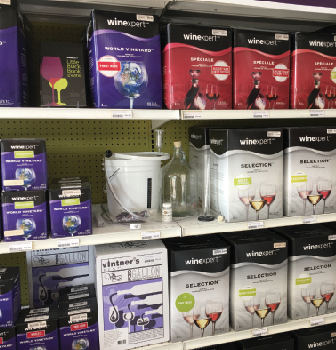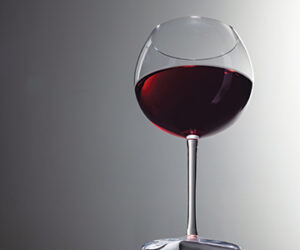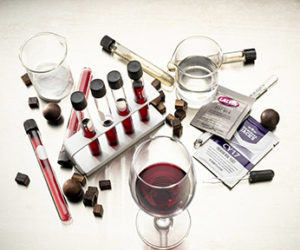 “A letter is an unannounced visit, the postman the agent of rude surprises. One ought to reserve an hour a week for receiving letters and afterwards take a bath.”
“A letter is an unannounced visit, the postman the agent of rude surprises. One ought to reserve an hour a week for receiving letters and afterwards take a bath.”
-Friedrich Nietzsche
Man, that Nietzsche was a grumpy Gus. I happen to love getting letters. Oh we get letters here at the “Wine Kits” column. We get questions, comments and requests for clarification, and sometimes we are even able to answer them! The great thing about letters is how much they tell you about what winemakers really care about — I might want to jabber on about the next great thing it wine kit technology, or why you should be cellaring all of your wines for a year before tasting them, but invariably folks would rather have me clarify what degassing is all about, or what their hydrometer is telling them. With that in mind, here are two of the things you are interested in.
Topping up with water
My kit instructions say that I should top up the carboy with water after I finish with fining and stabilizing. Sometimes that’s a lot of water, and even when it’s not, I don’t want to dilute my wine. Should I use finished wine instead?
– H2Obsessed in Hoboken
Excellent question! Water, water everywhere, and not a drop to put in your wine. Of course, if you think about it, didn’t you add a bunch of water to the kit when you stirred it up on the first day?
You have to add water to kit wines because they contain a certain proportion of concentrate. There’s a bit of confusion around why we use concentrate. Kit companies put concentrates in kits not because it’s cheaper than unconcentrated juice (it isn’t necessarily, as such — there’s cheap juice and expensive concentrate, and an unbreakable relationship between cost and quality in each).
The real reason we use concentrate is because it works as a preservative. If you’ve ever done home canning you’ll understand why. Jam is made from fruits with moderate to high acid levels, with sugar added to it. Acid means the pH is low, which prevents the growth of spoilage organisms and molds and slows browning. High sugar concentration is actually toxic to most cellular life — the osmotic pressure of high sugar solutions bursts their cell walls, killing them. When you concentrate fresh juice, you increase the acidity, lower the pH and raise the sugar level — voila, you’ve shelf-stabilized the grape juice without ruining the quality or using fierce chemical preservatives. Without concentrate additions, fresh grape juice has to be frozen or it spoils in short order.
The presence of concentrate means that when you make the kit you have to add water to it, usually to a volume of 6.1 US gallons (23 liters, 5 Imperial gallons). If you’ve ever wondered why kits are all 23 liters, it’s because every major kit company is Canadian and that was the common size of glass water bottles in the empire when home winemaking got started here, and we’ve stuck to it mostly because of momentum.
This is all well and good until the kit is transferred out of the first fermenting vessel into the carboy it will be shy just about a quart (a little less than a liter) of volume due to the amount of spent yeast cells, colloidal material and (if any) oak products or grape additions that are left behind as part of the process. No problem, until fining and stabilizing day: after you’ve added the stabilizers and the fining agents, the instructions say something like, “Top up the carboy to within 2 inches (5 cm) of the bottom of the bung. Use cool water. Topping up helps prevent spoilage.”
And the plain truth is that yes, the water will dilute the wine — but only to exactly the level it needs to be diluted! By design wine kits are made 4% over-strength, with higher Brix levels and more total dissolved solid material to compensate for the water addition. This works out to 23 liters + 4%, which is 0.92 liters, or almost exactly one US quart.
That 4% compensates for racking losses perfectly. And if you’ve made one of those specialty kits (usually a dessert-wine style) that start off at full volume with no added water in the primary fermentation, the same thing applies: we make those ones overstrength as well, so you can add that little bit of extra water and come out perfect.
I can see the evil glint in your eye from here, but please! Don’t add that extra quart on day one. If the kits worked that way, we would already have put it in the instructions. As it is, with most kits that would mean a completely full carboy at first racking, and not enough room in the carboy for the additions and stirring necessary at the fining and stabilizing step.
If it turns out that you need to add much more than a quart of topping water you a) have an oversized carboy, or b) didn’t add enough water on day one, or c) were too fussy at racking from the primary fermenter to the carboy. Double-check your carboy size (modern plastic carboys are usually very accurate, but there are some perplexingly random-sized glass ones out there). You can re-calibrate your primary fermenter by filling your (trusted) carboy to the neck with water, dump or rack it into the primary fermenter, let it settle and draw a plimsoll line around the outside of the fermenter with a permanent marker.
Fussy racking deserves special attention. The urge is to get the wine as clean as possible in the carboy — after all, that is the purpose of racking, to keep dead yeast and grape pulp from contaminating the wine, right? Not with wine kits; they don’t contain enough gross solids to worry about. Mainly you want to get the wine off of the spent yeast cells and away from the air, under an airlock. In truth you need to rack over everything except the lumps/oak chips/what have you from the primary fermenter — essentially, if it’ll go down the racking tube without fighting back, carry it over. It’s all going to be removed with the fining agents anyway.
So there you go, H2Obsessed: use water and save that topping wine for something more important — like topping up your glass.
Degassing debacle
I’ve had it with degassing. I used to spend hours stirring my wine with a spoon and it was still gassy. Then I got a drill-mounted whip, and when I stir it ten times for ten minutes I can’t get still wine — when I do that “puff test” there are still some bubbles. I read in a past “Wine Kits” column about a vacuum pump to degas wine – it’s that or I just start drinking sparkling Shiraz.
– Frustrated and Fizzy in Ferndale
Fizzdale, I feel your pain. Well, mainly I feel my pain, because this is one topic that never seems to go away.
Commercial wine is made on a schedule measured in years, while kit wines go to bottle in weeks. That means the yeast is going to make a lot of CO2 gas, which won’t have enough time to get out of solution. All wine kits contain the instruction “stir vigorously,” because you have to beat the wine, not stir it. Since you say you’re stirring well (way over the top, in fact) then it’s probably not your stirring effort that’s the problem. It’s almost certainly temperature.
Let me explain. Temperature of the must will determine not only how fast your yeast starts working and how quickly it consumes sugars and produces CO2; it will also govern how easily the wine will release that CO2 when it’s finished fermenting.
You need to make sure that your must is at or near the top of the temperature range specified in the instructions before you add the yeast. Yeast need a warm must to breed as quickly as possible, up to the population levels that trigger the start of alcohol fermentation, and then they need to be kept warm to work quickly, eating all the sugar and producing all of the alcohol and gas, because it’s only once they’re finished producing gas that it can start leaving solution. Too cold and it will take a lot of extra time, meaning the yeast might well be making CO2 right up until the day you start stirring, and it takes a lot of extra effort to degas fully saturated wine. Makes sense, right?
And don’t worry about a warm fermentation harming the wine, as long as you don’t go higher than the kit instructions say — commercial red wine fermentations are sometimes allowed to rise as high as 95 °F (35 °C) and it doesn’t hurt them at all.
The next part is a little less obvious, but the wine needs to be warm when you’re stirring to degas as well. This is because carbon dioxide dissolves into a liquid in inverse proportion to the temperature of the liquid. That’s why you chill Champagne, so it holds the CO2 and is fizzy, not flat. In fact, if you bring a glass of sparkling wine up to a boil, even for a single second, it will be completely flat (and hot, and weird-tasting, but that’s another matter).
If you pitched the yeast into a warm must, kept it warm throughout fermentation, and are stirring it warm, you should only need three or four bursts of super-vigorous stirring to get all the gas out, especially if you’re using a drill-mounted whip.
As for vacuum pumps, they are useful, but only (in my opinion) when you need to turn your wine around in an abnormally short amount of time. For example, the last time I used a pump to degas, it was to prepare a few carboys of wine for the a WineMaker Magazine Conference, and I was running out of time. Otherwise, all you need to do is stir as I’ve directed above and be patient.
Finally, you might just be over-thinking the puff test (for those following along at home who don’t know what the puff test is, this is a technique to test for residual CO2 when you fill a hydrometer jar halfway with the wine sample, seal it with the palm of your hand or an appropriate bung, and shake it like crazy. Release your palm/the bung and if there’s a “puff” of escaping gas, you know it needs more stirring). If there’s only the teeniest, tiniest change in pressure against your palm and a wee little puff, you probably have gotten the majority of the gas out, and can move on.
To test this, the next time you’re enjoying a bottle of commercial wine do a puff test on it. In a significant number of them you’ll find the tiniest bit of dissolved gas, especially in fruity, aromatic whites. Surprise! You don’t have to extract every last bit of gas in the wine, just the amount that you can detect on your palate and which could interfere with the mouthfeel or aroma.







